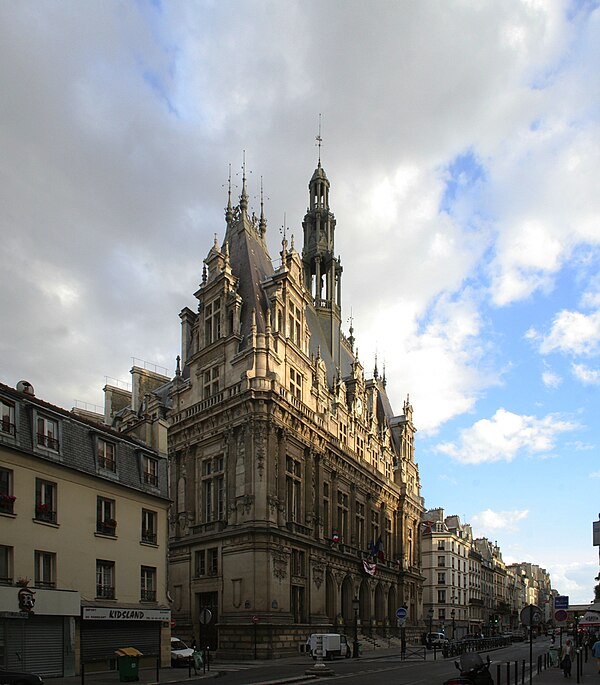Top Qs
Timeline
Chat
Perspective
10th arrondissement of Paris
Municipal arrondissement in Île-de-France, France From Wikipedia, the free encyclopedia
Remove ads
The 10th arrondissement of Paris (Xe arrondissement) is one of the 20 arrondissements of the capital city of France. In spoken French, the arrondissement is referred to as le dixième ([dizjɛm]; "the tenth", formally le dixième arrondissement de Paris). In 2020, it had a population of 83,459.
The arrondissement, called Entrepôt (warehouse), is situated on the right bank of the River Seine. It contains two of the seven large mainline railway stations of Paris: the Gare du Nord and the Gare de l'Est. Built during the 19th century, these two termini are among the busiest in Europe. The 10th arrondissement also contains a large portion of the Canal Saint-Martin, linking the northeastern parts of Paris with the Seine.
The current mayor of the 10th arrondissement is Alexandra Cordebard since 2017.[2]
Remove ads
Geography

The land area of the arrondissement is 2.892 km2 (1.117 sq mi; 715 acres).
The 10th arrondissement is often referred to as l'Entrepôt. Like all Parisian arrondissements, it is divided into four quartiers (districts):[3]
- Saint-Vincent-de-Paul, the 37th quartier, has 21,624 people in an area of 92.7 hectares
- Porte-Saint-Denis, the 38th quartier, has 15,066 people in an area of 47.2 hectares
- Porte-Saint-Martin, the 39th quartier, has 23,125 people in an area of 60.9 hectares
- Hôpital-Saint-Louis, the 40th quartier, has 29,870 people in an area of 88.4 hectares
Remove ads
Demographics
Summarize
Perspective
The peak population of the 10th arrondissement occurred in 1881, when it had 159,809 inhabitants. Today, the arrondissement remains very dense in both population and business activity, with 89,612 inhabitants and 71,962 jobs at last census in 1999. Due to its large Turkish minority, the 10th arrondissement is often called "La Petite Turquie" (Little Turkey).[4]
Historical population
Immigration
Remove ads
Map

Cityscape
Summarize
Perspective
- Place de la République
- Passage Brady
- Gare du Nord
Places of interest

- Canal Saint-Martin
- Gare de l'Est
- Gare du Nord
- Musée de l'Éventail (museum of fans)
- Passage Brady
- Passage du Prado
- Porte Saint-Denis
- Porte Saint-Martin
- Saint-Martin-des-Champs, Paris
- Saint-Joseph-Artisan, Paris
- Church of Saint-Vincent-de-Paul, Paris
- Church of Saint-Laurent, Paris
- Théâtre Antoine-Simone Berriau
- Chapel of Lariboisiere Hospital, Paris
- The House of African Worlds, or MansA[5]
Main streets and squares
Streets
- Rue d'Abbeville
- Rue Albert-Thomas
- Rue Alibert
- Rue d'Alsace
- Rue Ambroise-Paré
- Rue de l'Aqueduc
- Rue Beaurepaire
- Rue de Belzunce
- Rue Bichat
- Boulevard de Bonne-Nouvelle
- Impasse Bonne-Nouvelle
- Rue Bossuet
- Rue Bouchardon
- Passage Brady
- Passage du Buisson-Saint-Louis
- Rue du Buisson-Saint-Louis
- Rue Cail
- Rue de Chabrol
- Rue du Chalet
- Boulevard de la Chapelle
- Rue Charles-Robin
- Rue du Château-d'Eau
- Rue du Château-Landon
- Avenue Claude-Vellefaux
- Rue de Compiègne
- Rue Demarquay
- Boulevard de Denain
- Rue de Dunkerque
- Rue Eugène-Varlin
- Rue du Faubourg-du-Temple
- Rue du Faubourg-Poissonnière
- Rue du Faubourg-Saint-Denis
- Rue du Faubourg-Saint-Martin
- Rue Fénelon
- Rue de la Fidélité
- Rue de la Grange-aux-Belles
- Rue Guy-Patin
- Rue d'Hauteville
- Rue du Huit-Mai-1945
- Rue de l'Hôpital-Saint-Louis
- Rue Jacques-Louvel-Tessier
- Rue Jean-Moinon
- Rue Jean-Poulmarch
- Quai de Jemmapes
- Rue Juliette-Dodu
- Rue La Fayette
- Rue de Lancry
- Rue Léon-Jouhaux
- Rue Louis-Blanc
- Rue Lucien-Sampaix
- Boulevard de Magenta
- Rue de Marseille
- Rue Martel
- Rue de Maubeuge
- Rue de Mazagran
- Rue des Messageries
- Rue de Metz
- Rue Monseigneur-Rodhain
- Rue de Nancy
- Rue de Paradis
- Avenue Parmentier
- Rue Perdonnet
- Rue des Petites-Écuries
- Rue des Petits-Hôtels
- Rue Philippe-de-Girard
- Rue des Récollets
- Rue René-Boulanger
- Avenue Richerand
- Rue Robert-Blache
- Rue de Rocroy
- Boulevard Saint-Denis
- Impasse Sainte-Marthe
- Rue Sainte-Marthe
- Rue Saint-Laurent
- Boulevard Saint-Martin
- Rue Saint-Maur
- Rue de Saint-Quentin
- Rue Saint-Vincent-de-Paul
- Rue de Sambre-et-Meuse
- Rue Sibour
- Boulevard de Strasbourg
- Rue du Terrage
- Rue Tesson
- Rue Taylor
- Quai de Valmy
- Avenue de Verdun
- Rue Vicq-D'Azir
- Boulevard de la Villette
- Rue des Vinaigriers
- Rue Yves-Toudic
Squares
|
|
Remove ads
References
External links
Wikiwand - on
Seamless Wikipedia browsing. On steroids.
Remove ads










